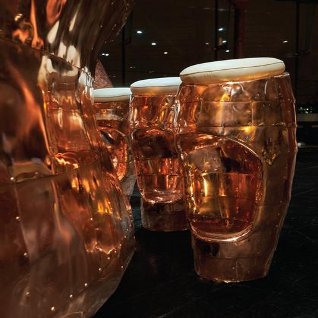Ketel One bar, London
From the copper stills used in the 17th-century to make Ketel brand vodka came the inspiration for this largely all-copper interior – and a reawakening of metalwork craftsmanship
Details
Client: Ketel One
Design: Christopher Jenner
Size: 110 sq m
Completion time: Three months
Photography: Michael Franke
Project Details
The last time we featured a project by interior design practice Christopher Jenner (then Jenner Studio), it was the fabulous Diptyque store in New York City, a scheme remarkable for its myriad luxurious materials including Greek Thassos marble, American oak and hand-blown glass. The practice’s latest project, a bar inside London’s Gilgamesh restaurant for Dutch vodka brand Ketel One, is a different story as everything in the space is covered in a single material – copper – to represent the traditional copper stills used to make the vodka.
‘Normally we use multiple techniques, materials and manufacturing processes to deliver our work,’ says founder and head designer Christopher Jenner, ‘but on this occasion we committed to a single material.’
Founded in 1691, Ketel One is named after Distilleerketel #1, the original copper still used to make it, and Jenner decided to represent this in the design, using copper strips to cover the entire bar as well as the bar stools.
Using a single material meant the initial design process was relatively straightforward. However, implementing the scheme was tricky. ‘From a manufacturing and realisation point, we were totally in the dark,’ says Jenner. ‘The way in which we constructed the pieces was unprecedented and this meant we had to develop new manufacturing processes.’
First, the bar and bar stools were built using skeletons of wood and metal. These were then covered in vertical strips of copper, which had been heated to make them malleable. The copper strips were then riveted to the skeleton structures before being covered in an overlapping copper sheet, which was double-riveted to create a seamless copper surface. More than 1,000kg of copper and 10,000 rivets were used.
Despite the obvious difference between this project and the Diptyque store, Jenner says the two projects actually have a lot in common: ‘This project fits perfectly with our goal of applying traditional crafts skills in new ways,’ he says. ‘For both the craftsmen working on the project and ourselves it’s a great opportunity to see a beautiful material used in such a uniquely challenging way.’
He continues: ‘Using copper to the extent we did was the most challenging and rewarding part of the project. This was very much a design-led project where the material crafting process was “discovered” as we brought the design to life.’
This article was first published in fx Magazine.












